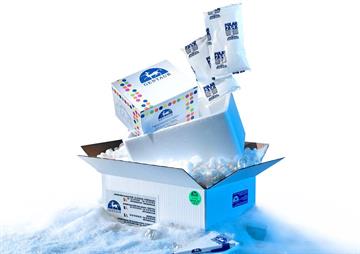Anti-Human Dkk-1 Antibody

Anti-Human Dkk-1 Antibody
339 EUR
In Stock
quantity
Produktdetaljer
Katalognummer: 209 - 102-PA33S
Produktkategori: Företag och industri > Vetenskap och laboratorium
ReliaTechGentaur
Storlek: 100 µg
Related Products
102-PA33
Anti-Human Dkk-1 Antibody
DKK-1 is a member of the DKK protein family which also includes DKK-2, DKK-3 and DKK-4. DKK-1 was originally identified as a Xenopus head forming molecule that behaves as an antagonist for Wnt signaling. Subsequent studies have shown that DKK-1 and DKK-4 play an important regulatory role in the Wnt /β-catenin signaling pathway by forming inhibitory complexes with LDL receptor-related proteins 5 and 6 (LRP5 and LRP6), which are essential components of the Wnt/βcatenin signaling system. LPR5 and LPR6 are single-pass transmembrane proteins that appear to act as co-receptors for Wnt ligands involved in the Wnt/βcatenin signaling cascade. It has been suggested that by inhibiting Wnt/β-catenin signaling, which is essential for posterior patterning in vertebrates, DKK-1 permits anterior development. This notion is supported by the finding that mice deficient of DKK-1 expression lack head formation and die during embryogenesis. Recombinant human DKK-1 fused to a C terminal His-tag derived from E. coli is a 26 kDa protein containing 235 amino-acid residues.
457.12 €
102-PA33S
Anti-Human Dkk-1 Antibody
DKK-1 is a member of the DKK protein family which also includes DKK-2, DKK-3 and DKK-4. DKK-1 was originally identified as a Xenopus head forming molecule that behaves as an antagonist for Wnt signaling. Subsequent studies have shown that DKK-1 and DKK-4 play an important regulatory role in the Wnt /β-catenin signaling pathway by forming inhibitory complexes with LDL receptor-related proteins 5 and 6 (LRP5 and LRP6), which are essential components of the Wnt/βcatenin signaling system. LPR5 and LPR6 are single-pass transmembrane proteins that appear to act as co-receptors for Wnt ligands involved in the Wnt/βcatenin signaling cascade. It has been suggested that by inhibiting Wnt/β-catenin signaling, which is essential for posterior patterning in vertebrates, DKK-1 permits anterior development. This notion is supported by the finding that mice deficient of DKK-1 expression lack head formation and die during embryogenesis. Recombinant human DKK-1 fused to a C terminal His-tag derived from E. coli is a 26 kDa protein containing 235 amino-acid residues.
339 €
101-M380
Anti-Human Dkk-1 Antibody
Dkk1 is a Dickkopf-related protein that inhibits Wnt signaling by binding the Wnt coreceptor LRP5/6. It also binds Kremen1 and Kremen2. Dkk1 is important in embryonic development.
748.5 €
101-M46
Anti-Human TIE-1 Antibody
TIE-1 (tyrosine kinase with Ig and EGF homology domains 1) and TIE-2/Tek comprise a receptor tyrosine kinase (RTK) subfamily with unique structural characteristics: two immunoglobulin-like domains flanking three epidermal growth factor (EGF)-like domains and followed by three fibronectin type III-like repeats in the extracellular region and a split tyrosine kinase domain in the cytoplasmic region. These receptors are expressed primarily on endothelial and hematopoietic progenitor cells and play critical roles in angiogenesis, vasculogenesis and hematopoiesis.
433.5 €
101-M47
Anti-Human TIE-1 Antibody
Tie-1/Tie and Tie-2/Tek are receptor tyrosine kinases with unique structural characteristics including two immunoglobulin-like domains flanking three epidermal growth factor (EGF)-like domains, followed by three fibronectin type III-like repeats in the extracellular region, and a split tyrosine kinase domain in the cytoplasmic region. Tie-2 is a receptor for the angiopoietin (ANG) family: ANG-1, ANG-2, and ANG-3 (mouse)/-4 (human). It is involved in vascular stabilization and remodeling. Although less well understood, Tie-1 may also act as an ANG receptor, possibly in complex with Tie-2.
748.5 €
101-M48
Anti-Human TIE-1 Antibody
Tie-1/Tie and Tie-2/Tek are receptor tyrosine kinases with unique structural characteristics including two immunoglobulin-like domains flanking three epidermal growth factor (EGF)-like domains, followed by three fibronectin type III-like repeats in the extracellular region, and a split tyrosine kinase domain in the cytoplasmic region. Tie-2 is a receptor for the angiopoietin (ANG) family: ANG-1, ANG-2, and ANG-3 (mouse)/-4 (human). It is involved in vascular stabilization and remodeling. Although less well understood, Tie-1 may also act as an ANG receptor, possibly in complex with Tie-2.
433.5 €
Håll dig uppdaterad! Visa tidigare publikationer

By: Author , 2 Comment
Anaplasmos hos hundar och katter – allt du behöver veta
23 August 2025

By: Author , 2 Comment
Solbränna – hur leker man säkert i solen?
16 August 2025

By: Author , 2 Comment
Biologiska läkemedel – Modernitet inom farmaci
1 August 2025

By: Author , 2 Comment
Icke-steroida antiinflammatoriska läkemedel – viktig information om populära läkemedel
22 July 2025








